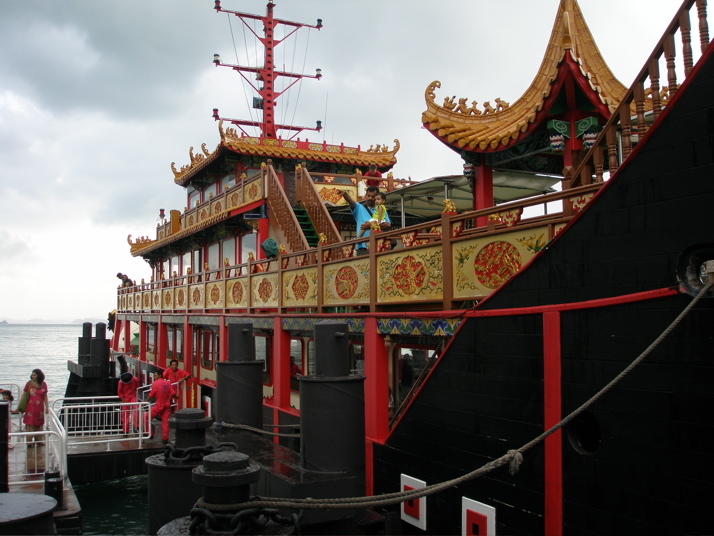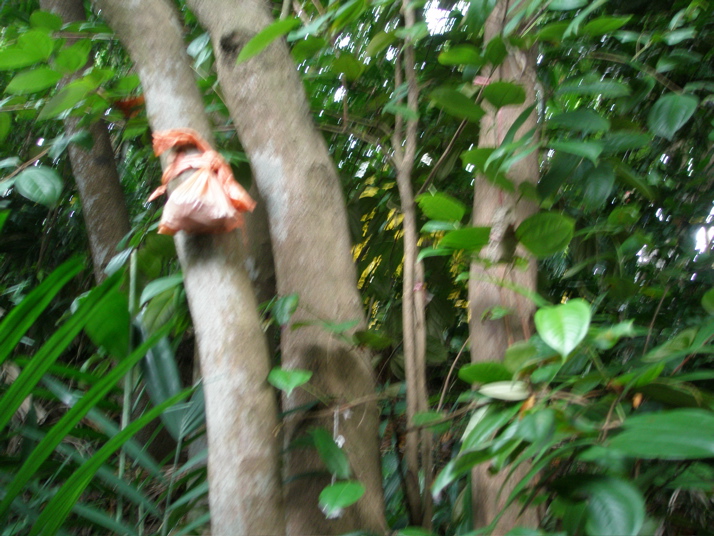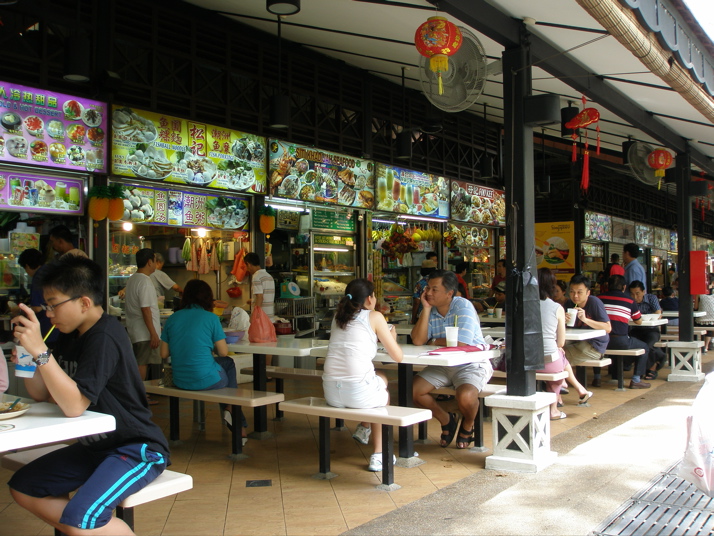The Singapore Sling is a drink originated at the Raffles Hotel. Now if you want one there in a reproduction of the original bar, it will set you back $13US ($21 Singapore). It is a fruity, sweet drink that some find cloying.
Singapore works
I am continually amazed at how well things in Singapore work. Every detail seems to be thought through. Granted, some seem a bit over regulated, but the rules are for the good of all.
- No gum chewing. While you can have a few sticks for personal consumption, you are not allowed to sell it. Why the ban? Because gum carelessly discarded makes for dirty sidewalks and streets. Who likes to scrape off the yucky mass after stepping in soft gum?
- Uniformed men and women troll the streets cleaning up cigarette butts and debris. There is a fine for littering — $1000 — so there is very little trash lying around. The public trash cans are emptied regularly, so I’ve rarely seen one overflowing. (There are also fines for spitting, jaywalking and not flushing a public toilet.)
- To discourage people from driving and encourage public transportation, cars are assessed a fee for entering core areas during rush hour. How is this collected? All cars have an electronic meter that automatically deducts the fee when they enter the area. This is also how they pay parking fees — at the entrance your time is noted and at exit your fee is deducted from your electronic meter. Very efficient. No long lines waiting to pay parking fees.
- Even bathrooms have an efficiency I wish would be adopted in the US. When you lock your stall, the outside shows a red “occupied” symbol. When it’s vacant, the symbol is green. This saves women from having to stoop to see if any legs are showing underneath the door.
- There’s a $1 deposit on Metro (called the MRT) tickets. When you buy one you pay $1 more than the fare needed. When you arrive at your destination, you insert your spent ticket into the machine and it dispenses $1 back. These tickets are then reused. The MRT is clean, graffiti-free, air conditioned and on time.
- No bicycles are allowed on the downtown streets. I’m imagining this is not only for safety but for traffic flow. However, bicycle rickshaws are allowed in certain tourist sections.
- There are few horns honking on the roads, unlike India where it seemed de rigueur to honk at every opportunity. Singaporeans seem to like quiet. Even the motorcycles are quiet.
These are the local equivalent to fast food. There are many stalls in a large circle ringed by tables. You can get fresh-squeezed juice (I had mango — yum!), Chinese, Indian or Malay food. There are pictures of the plates so you can see what you’re getting. The tables are bussed and cleaned by attendants.
Considerate people
The Singapore government launched a consideration campaign some years ago, encouraging Singaporeans to be considerate to each other. It seems to have worked pretty well. There is no shoving or cutting in lines, people say “excuse me,” and generally they are polite, even on busy streets.
When I asked my seminar attendees to list some pet peeves for an exercise we were doing, one man said “People who don’t yield their seats on the bus or MRT to the elderly or pregnant.” Interesting. I hadn’t heard that complaint in the many years I’d been doing that exercise. But I thought it was indicative of the consideration campaign. It obviously got to him.
 Singapore by sea
Singapore by sea
At the MRT passenger service counter I met Mo, a Moroccan-born, Miami-based executive working in Singapore for 3 months. We were both asking directions from the MRT to the Chinese boat tour of the harbor. We walked to the bus stop to await our bus and stuck together for much of the trip. He was a nice enough fellow to pass the time with. It was rainy, so not many people opted for this attraction.
The ride was relaxing, and the recorded tour pointed out many sites and history. The harbor was full of hundreds of ships stacked high with containers or sitting low full of crude oil.
 We stopped at Kusu (Turtle) Island where we had 45 minutes to explore this small outcropping, with pristine, protected beaches, myriad picnic tables under trees, and two temples. One was reached by climbing 152 stairs to find a priest giving blessings of good luck and prosperity. Worshipers hang blessed rocks in the trees for the gods to grant their wishes. The priest will gladly give you a rock and string to tie onto a tree if you didn’t bring your own. (This is a pic of rocks tied in red bags on trees.)
We stopped at Kusu (Turtle) Island where we had 45 minutes to explore this small outcropping, with pristine, protected beaches, myriad picnic tables under trees, and two temples. One was reached by climbing 152 stairs to find a priest giving blessings of good luck and prosperity. Worshipers hang blessed rocks in the trees for the gods to grant their wishes. The priest will gladly give you a rock and string to tie onto a tree if you didn’t bring your own. (This is a pic of rocks tied in red bags on trees.)
Getting beautiful in Singapore
I decided to be adventurous and again have my hair done, but this time not colored. I made an appointment at the beauty salon next to my tailor, which is in a large shopping mall next to my hotel. It is like a little city, with nearly all your needs being handled under one roof. I’ve had a suit made, nails done, dry cleaning dropped off (and then delivered to my hotel), had dinner, shopped, bought groceries and would have had a massage but their prices were double what I paid in Chinatown a few weeks ago.
My hair stylist is the manager. She instructs the shampoo girl to begin. Instead of taking me to the shampoo bowl, the young woman puts a handful of shampoo directly on my head and adds water from a bottle. She massages this in until frothy. She continues for 10 minutes adding more shampoo until my head is full of white foam. She massages my scalp, neck and shoulders — yum! Then she takes me to the shampoo bowl for a rinse. I wondered how she was going to get all those suds off.
She and the manager stood on either side of me with blow dryers in hand. My hair has never dried that fast. Then they each got out flat irons and soon my usually somewhat-frizzy hair was as smooth as glass. It was shinny and I told these Chinese-Singaporeans my hair looked as lovely as theirs.
By happenstance, I am here a few weeks before Chinese New Year, which this country takes very seriously. The hotels and shopping centers display beautiful decorations. Chinatown is bulging with street vendors hawking decorations and special foods for the holiday. The locals give special food to each other as thanks for kindnesses throughout the year.
One of my clients gave me a beautifully packaged container of pineapple tarts — this is a very popular gift. Another popular food is a melt-in-your-mouth dried BBQ pork, beef, or chicken called bah quah. But this yummy treat is softer than the jerky we have in the US.
Banks give out empty “red packets” — money envelopes for gifts. These are rationed out one pack of 10 per customer as they are much in demand. But a bank officer from one of my seminars gave me two sets as a thank you for the class. Not having a need for 20 red envelopes decorated in gold Chinese lettering, I passed on all but a few to some local friends who would use them.
A local friend took me to the Chinese markets where I purchased some Chinese coins to put in my wallet so they’d attract more currency, and a small decorated gourd to put in the room of anyone who’s sick to help them get well. She also showed me a pair of stone Chinese Mandarin duck carvings and said these were to be put in the bedroom to attract love into your life. I passed on purchasing the ones she showed me but now want to go back to get some. She said within a month of her purchasing her pair she met her boyfriend of 4 years!
Be a clown!
With the eight different audiences I’ve had, I’ve learned that Singaporeans love silliness. The more of a clown I am, the more they love it. I’m told they love Mr. Bean. I’ve never considered myself close to his childishness, but think I may have to watch his TV shows to study up before I return here in April.

